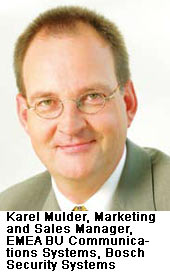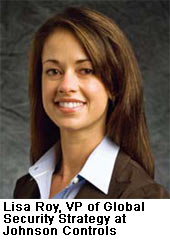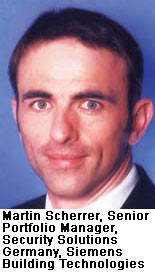Business is tied closely to decision making. Generating the biggest bang for the buck is especially important during an economic downturn. A&S takes a look at how integrated security and safety solutions secure commercial buildings more efficiently.
Business is tied closely to decision making. Generating the biggest bang for the buck is especially important during an economic downturn. a&s takes a look at how integrated security and safety solutions secure commercial buildings more efficiently.
Securing valuable assets and protecting people's safety are required for successful business. Increased awareness for cost and efficiency among corporations stimulates market growth for building automation, security and fire solutions.
"Although the financial crisis worldwide has curtailed corporate spending and delayed some major projects, the security market continues to grow," said John Knapp, Product Line Manager at Stanley Security Solutions.
Despite a slackening in demand, security for office buildings continue to boom. “The growth rate for commercial building security is still expanding, although it has slowed down compared to what it was in 2007 and 2008,” said Bhaskar Ganguly, Global Director, Marketing, Critical Infrastructure Protection, Honeywell ACS.
 Dilip Sarangan, Industry Analyst for Physical Security at Frost & Sullivan predicted growth for commercial security worldwide in the second half of 2009, reaching 8 to 10 percent in the next few years. Knapp expected higher growth of 20 percent CAGR, with the market remaining the same size as 2008.
Dilip Sarangan, Industry Analyst for Physical Security at Frost & Sullivan predicted growth for commercial security worldwide in the second half of 2009, reaching 8 to 10 percent in the next few years. Knapp expected higher growth of 20 percent CAGR, with the market remaining the same size as 2008.
Threats
Businesses face a range of threats, including fraud, theft, burglary, vandalism and terrorism. "Building owners need to draft their assessment analysis internally or with help from outside professionals to make sure policies and solutions are customized for the particular building," Ganguly said.
Theft Prevention
Preventing theft means effective access control must be implemented, making it a concern for commercial buildings. Buildings that host multiple companies emphasize integration of physical and logical access control.
Integration between surveillance cameras, VMS and third-party devices can be made easier using standard IP protocols, said Oh Tee Lee, Regional Director, South Asia Pacific, Axis Communications.
Alarms also play an important role in total solutions. "Intrusion is a priority, especially intrusion detection by night when there is nobody inside the building," said Dominique Auvray, Marketing Director, Gunnebo.
As security threats change during the day at the same location, systems can be managed accordingly. Certain rooms that are protected during business hours by access control and video surveillance can be watched by intrusion and video surveillance outside operation hours, said Dave Jansen, Business Development Manager, Bosch Security Systems.
 Terrorism
Terrorism
Deliberate acts of violence can result in massive casualties, such as the Sept. 11, 2001 attacks. A bomb could cause fire and cause injury or fatalities. Natural hazards, such as earthquakes or floods, pose the same risks. The outcomes and required responses for these scenarios are largely the same, Ganguly said.
Buildings should have tailored security solutions for possible terrorist events. "Every customer or business has different needs, so the systems for prevention, detection, containment and the escape plan must be designed carefully to ensure building and people safety," said Mark Brisson, Managing Director, Hong Kong, Macau and Taiwan, UTC Fire & Security.
Tenants can be efficiently notified with PA and voice alarms integrated with fire, building management systems, touch panels, PC call stations and automatic announcement systems, said Karel Mulder, Marketing and Sales Manager, EMEA BU Communications Systems, Bosch Security Systems.
Emergency Response
When faced with safety or suspicious activities, building management should contact the authorities. "In Norway, only police has the right to stop an intruder. Therefore, whether a security system can efficiently notify the police force in case of a break-in is very important," said Arne Grave, Sales Manager at G4S Security.
Having a good evacuation plan can avoid panic, Mulder said.
"There are many factors to consider when evacuating a location, including the nature of the threat, the fastest route to safety, and the elimination of potentially disastrous bottlenecks," said Sean Pang, Senior Marketing Manager, Asia Pacific, Bosch Security Systems.
With situational awareness, firefighters can plan and act more efficiently, Ganguly said. Muster points with access card readers provide identification of any registered person reported missing, while access logs can identify their last-known locations.

Locations of readers, types of door locks and antipassback systems should be considered, said Eric Assouline, Export Sales Manager at CDVI.
Building Automation
Building automation with a building management system (BMS) controls and minimizes energy consumption. "However, the BMS has often been left to operate with the parameters that were set during its initial installation," said Scott Petersen, Marketing Director, Energy Solutions, Honeywell EMEAI.
According to the actual usage of a facility — including occupant information, current weather conditions, heating and cooling load — building automation automatically implements strategies to improve efficiency “A BMS needs to be fine-tuned on a continuous basis if savings are to be made and sustained,” said Lisa Roy, VP of Global Security Strategy at Johnson Controls.
Energy Saving
Buildings that utilize green security solutions benefit from operational cost reduction and enhancement of their brand and corporate image.
An integrated approach to energy management in commercial buildings is important if energy costs and carbon emissions reduction are to be achieved, Petersen said.
"Around 75 percent of the world's electric energy is used by buildings and approximately 50 percent of it is used in nonresidential buildings," Roy said.
 Energy management software monitors and reports energy performance and usage, making it crucial for building automation to track energy consumption, said Jorge Moreno, Program Manager for Environmental & Building Technologies at Frost & Sullivan.
Energy management software monitors and reports energy performance and usage, making it crucial for building automation to track energy consumption, said Jorge Moreno, Program Manager for Environmental & Building Technologies at Frost & Sullivan.
Climate Control
HVAC provides optimal comfort for occupants and is the largest energy load in a building. According to the US Department of Energy, energy consumption from HVAC systems accounts for 40 percent of the total energy used in buildings, Moreno said.
To reduce energy and be more environmentally friendly, commercial buildings have several options. Boiler plant replacement and upgrades, optimizing operating temperatures and chiller operation, variable speed drives on pump motors and thermostatic valves on radiators are separate ECMs (Energy Conservation Measures) considered for energy optimization, Petersen said.
Lighting Control
Lighting constitutes about 30 to 35 percent of the total energy load in commercial buildings, said Moreno. Up to 50 percent of this energy is wasted either by inefficient lighting, occupants being careless about their lighting habits or both.
Lighting energy consumption can be reduced by 15 to 30 percent if improvements are made. These include replacing lamps with energy efficient ones, and PIR and motion sensors within the BMS, Petersen said.
Other options include intelligent blind control, which automatically detects lighting levels inside and adjust blinds to save energy during daytime, said Walter Krambring, Portfolio Architect, Security Systems and Products, Security Solutions, Siemens Building Technologies.
 Surveillance cameras using PoE technology can reduce energy consumption. Buildings with PoE switches need fewer power supply points, Lee said. Well-designed cameras consume less energy and emit less heat.
Surveillance cameras using PoE technology can reduce energy consumption. Buildings with PoE switches need fewer power supply points, Lee said. Well-designed cameras consume less energy and emit less heat.
Planning
The five components of an effective building security program are: commitment from management; assessment of risk; creating and auditing security policies and procedures; installation of security systems and upgrades; and establishment of security training. Ideally, the first two are part of the initial design, including choice of location, Ganguly said.
While security systems must protect valuable assets and human lives, building owners prefer systems to be as invisible and unobtrusive as possible, said Martin Scherrer, Senior Portfolio Manager, Security Solutions Germany, Siemens Building Technologies.
Key factors are location, tenant mix and people-vehicular flow, Brisson said. They determine potential security risks, which should be ranked from low to high.
An integrated security solution usually includes access control, monitoring, surveillance, lighting and parking lot control. The solution should be open for third-party integration and scalable for system upgrades. Structured cabling systems can facilitate the scalability of video surveillance, Lee said.
When designing security and safety measures for commercial buildings, country specific regulations must be considered, Krambring said.
 Challenges
Challenges
Challenges for commercial building security and safety include slow market adoption for building automation. The digital era ushers in challenges for IP migration, such as interoperability and compatibility of IP based systems. Finally, infrastructure design for security must strike a balance between security, safety and convenience.
"Building automation has been on the market for a long time, but not many buildings have it implemented," Sarangan said. "Currently, market acceptance for building automation technology is not high, though it is increasing with a promising future."
Commercial buildings need to balance the creation of a secure environment for tenants, while maintaining an inviting and pleasant environment for employees and visitors, Roy said.
Outlook
In the short term, businesses are spending more cautiously. Existing systems are used longer with investments made in classic security and mixed systems. As a result, requirements for maintenance and service will increase, Krambring said.
Monitoring the perimeter will be a focus for commercial buildings. "There will be an increase in requests for outdoor day-night cameras for external building surveillance," Lee said.
Networking will be a growing trend. “Buildings are more and more prewired for Ethernet networks,” Auvray said. “Then the peripherals need to be 'native IP.' In new buildings, there are fewer cables dedicated to security installations.”
As convergence grows, it will be implemented in more commercial buildings around the world, adding convenience, safety and security.